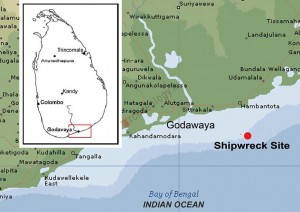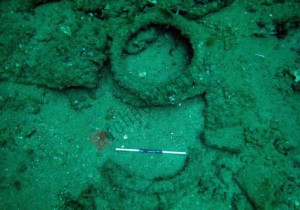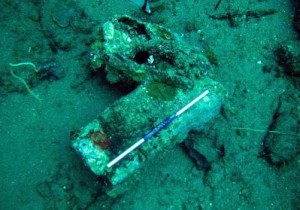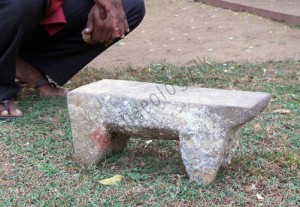This article was first published in the “Bulletin of the Australasian Institute for Maritime Archaeology (2011), 35: 9ÔÇô17″. ┬áPublished in archaeology.lk with the permission from ┬áR. Muthucumarana
A.S. Gaur1, R. Muthucumarana2, W.M. Chandraratne2, B.C. Orillandeda3, M. Manders4, S. Karunarathna2, P. Weerasinghe2,
A.M.A. Dayananda2, T. Zainab5, A. Sudaryadi6, K.A.B.A. Ghani7, J. Wahjudin6, N. Samaraweera2.
1. National Institute of Oceanography (CSIR), Dona Paula Goa, India. Email: <asgaur@nio.org
2. Maritime Archaeology Unit, Central Cultural Fund, Fort, Gale, Sri Lanka.
3. Underwater Archaeology National Museum of the Philippines, P. Burgos Street. Manila 1000, Philippines.
4. Rijksdienst voor het Cultureel Erfgoed Smallepad 5, 3811 MG Amersfoort, The Netherlands.
5. Directorate of Coastal and Marine Affairs, Mina Bahari II Building, 7th Floor Jl. Medan Merdeka Timur No. 16, Jakarta-
Indonesia 10110.
6. Archaeology and History, JI. Letnan Jidun (Komplks Perkantoran, Serang, Banten 42115, Box Office 204, Indonesia.
7. Conservation and Archaeology Division, Level 1, Chulan Tower, Jalan Colony, 50450 Kuala Lumpur, Malaysia.

Introduction
An international team comprised of experts in diving and underwater archaeology from Sri Lanka, India, Indonesia, Malaysia and the Philippines participated in the assessment of a shipwreck at Godawaya, Sri Lanka. The main objective of the exploration was to make assessment of the wreck site based on the data generated during the fieldwork. The shipwreck is lying or trapped in an isolated reef (which virtually surrounded the wreck and only the northeastern part is exposed) in 31 m water depth. The observation of surface distribution suggests that the site is spread over an area of 40 m by 22 m. The important findings include various sizes of jars, carinated cooking vessels, quern stones and unidentified cargo and possible ship structure. The analysis of pottery retrieved earlier and observed during the present investigation suggests that the pottery is not similar to those found from the shipwrecks of the 10th century AD onwards. Comparative study of pottery and stone artefacts indicate a possible time bracket for this wreck to be between the 4th century BC and the 2nd century AD.

Background information
In ancient times Godawaya was known as Godapavatapatanahathat is mentioned in a Brahmi inscription┬áfound in Godawaya (Falk 2001: 328) dated to the 2nd┬ácentury AD (Roth et al. 2001: 296), and in Mahavamsa┬áthe etymological identifiable term ÔÇÿGotapabbataÔÇÖ is┬áused (Geiger 1912: 255). There are two other Brahmi┬áinscriptions reported from Godawaya area. The earliest┬áarchaeological evidence from Godawaya trace the history┬áof this region from the Mesolithic period onward. The┬áMesolithic site is situated on the eastern bank of the river┬áWalawe Ganga, on a raised hillock and a few projected┬áboulders might have served as shelter for prehistoric people.┬áThe river merges with the sea immediately after the site.┬áGodawaya is a small fishing village (Fig. 1), situated┬ábetween Ambalantota and Hambantota near the mouth of┬áthe river Walawe Ganga that is the fourth biggest river of┬áthe country on the southern coast of Sri Lanka. However,┬áthe mouth of the river near Godawaya is blocked by sand┬ádeposit and now the river is debouching in the sea at┬áAmbalantota 3 km west of Godawaya. Along the course┬áof Walawe River a number of ancient settlements and┬ámonasteries such as Ridiyagama, Mahanavulupura and┬áRamba monastic complex have been either excavated or thoroughly explored. There are also reports on the discovery of Indo-Roman coins from this area (Burnett 1998).


A land excavation was conducted by the Archaeological Department of Sri Lanka and the German K.A.W.A. project in the last decade of the previous century. ┬áAfter a series of explorations and excavations from 1994 at Godawaya some of the very significant structural remains such as a temple, harbour and an important inscription were unearthed (Ruth 1998). An inscription carved on a natural rock north of the Stupa states about a seaport situated at Godawaya (Falk 2001). The present paper deals with the underwater explorations at the wreck site off Godawaya that is lying in 32ÔÇô33 m of water. The programme was jointly organized by the Central Cultural Fund of Sri Lanka, UNESCO and the Cultural Heritage Agency of the Netherlands. The preliminary investigation indicates that wreck may be a wooden-hulled vessel dated to the early historical period. On the basis of archaeological findings the date of the wreck will be discussed in detail.
Methodology
Three fibre boats were hired for the underwater inspection┬áof the wreck site. These boats are 19 ft (5.79 m) long and┬á6 ft (1.82 m) wide. In the absence of any jetty or harbour┬áin Godawaya, the boats were pushed manually into the┬ásea and taken out every day. The exploration team is┬ácomprised of 10 full-time divers and 2 part-time (6 from┬áabroad, 4 from the Maritime Archaeology Unit[MAU]┬áand 2 from Godawaya). Two members had underwater┬ádigital cameras for photography. Further, three sub teams┬áwere formed and each team consisted of 3 divers. Two┬ádivers worked on assigned tasks, while the job of third┬ádiver was to monitor the activity and dive times. Due to┬áthe absence of a decompression chamber at the site, dive┬ábottom time was limited to 18 minutes, the maximum┬átime allowed for a no-decompression dive.┬áTwo buoys were initially placed over the site; these also┬áserved as shot lines for diver entry and exit. Using a rope┬áwith a metre tape attached, a 50-m baseline was established┬áon a bearing of 300┬░. The length was then divided into┬áthree divisions that served as the teamsÔÇÖ respective area┬áof assignment. All observed archaeological features and┬ácultural material were plotted using the offset method,┬áand each artefact was described and measured (length,┬áwidth and height). One team was tasked to do site┬áphoto-documentation using two digital cameras and one┬áunderwater video camera; recording on-site activities and┬átake photographs of individual artefacts. The mound of┬átimbers or planks on the northern side of the baseline was┬árecorded in detail. Based on collected data, a preliminary┬ásite map was created.
Results
The site of the Godawaya shipwreck is situated about 4 km south-east of the Godawaya monastery and water depth varies between 29 m and 32 m. The seabed near the site is comprised of coralline rocky formation, whereas towards the north-eastern part of the site a wide area is covered with thick-grained coralline sand. The maximum height of the reef on the north-western part is approximately 1.5 m. No vegetation growth was observed at the site; however, in a few places, gorgonian growth was noticed besides some marine pinkish layer on the rocks.
The measurements of the artefacts visible on the┬ásurface indicate that the site is spread in a 40 m eastÔÇôwest and 22 m northÔÇôsouth direction (Fig. 2). However,┬áextension of the site may increase when surface sand is┬áremoved. Interestingly, at one place the removal of sand┬áby hand fanning yielded a number of potsherds just below┬á10 cm in the sediment. Thus the actual extent of the site┬ámay be determined only after thorough examination of┬áthe site by the removal of surface sediments.
Numerous artefacts were observed on the seabed, including varieties of pottery, stone benches/querns, and a large area in the north-western part was covered with the remains of a shipwreck with unidentified cargo.
There are several potsherds lying on the wreck site area which comprise two huge storage jars (Figs 3 & 4), medium sized jars, carinated cooking vessel besides a number of rims of jars (Fig. 5) and body parts of other pots. The surviving height of two storage jars was 100 and 85 cm respectively and the diameter of the rims 45 and 40 cm respectively.
Another interesting find from the wreck site includes stone benches or querns (Fig. 6). There are four such artefacts and they are of various sizes (Table 1). A few stone benches were also found attached either to wreck parts or some other encrustation. Therefore, the actual size may be slightly different when measurements are obtained after retrieving the artefacts from the wreck. The benches are rectangular in shape with four legs which serve as a base.
| Sr. no. | Length(cm) | Width(cm) | Height(cm) |
| 1. Displayed at Maritime Museum, Galle | 37.5 | 15.5 | 16.5 |
| 2. Underwater (in situ) SB 1 |
30 |
20 |
10 |
| 3. Underwater (in situ) SB 2 |
45 |
30 |
26 |
| 4. Underwater (in situ)SB 3 |
45 |
30 |
20 |
| 5. Underwater (in situ) SB 4 |
37 |
16 |
10 |
Table 1.    The details of measurements of Quern Stone
| Registration no. | Height(cm) |
Diameter (cm) |
Weight (g) |
| 2 0 0 8 / S L / S /  GODA/M/2/01 |
9 |
19 |
3987.6 |
| 2 0 0 8 / S L / S /  GODA/M/2/09 |
9 |
18 |
2722.4 |
Table 2.   Details of glass ingots retrieved from the wreck site
The raw material used for these benches appears to be basalt. Due to thick encrustation growth over these artefacts no symbol or designs could be noticed. However, a bench retrieved earlier by local divers has some symbols (Fig. 7) on the extended front portion.
Other important finds from the wreck are glass ingots. Two ingots were retrieved earlier and are presently displayed in the Galle Fort Maritime Museum (Table 2). They are blue in color and semi spherical or bun-shaped. As per the report from the earlier investigation, there are about 3 or 4 ingots visible on the surface (Fig. 8).
In the north-west part of the site a large area with wreckage was noticed (Fig. 9). This area is divided into two separate blocks and appears to be parts of the cargo. From the surface observation they appear to be wooden logs covered with marine growth. One block measures 4.6 m in length and 1.2 m in width. This block is further divided into 2 bunches. The height is about 1 m with at least 4 layers visible. However, the entire wreckage part has been integrated due to being overgrown with marine encrustation, thus making it difficult to identify. Another big block is squarish, 3.9 m long and 3.7 m wide, and further subdivided into four blocks. The height of this block is c. 1.2 m. The measurement of a log is c. 10 x 15 x 200 cm. The blocks appear to be the major part of the cargo of the ship. From their shape and size they at first appear to be wooden planks, but from close observation underwater the material does not appear to be wood. It is possibly metal. This needs to be further investigated.
Discussion
Many ships have been wrecked around Sri Lanka (Manders et al. 2004) but Gudawaya is a very unique shipwreck and no parallel has been reported in publications. It is therefore of the utmost importance to continue the investigation of this site in order to fill in the gaps of our knowledge about early historic trade. The material found from this wreck such as pottery, stone quern, glass ingots, wreckage parts and the possible date of this wreck will be discussed in the following paragraphs.
Pottery
Pottery discovered at shipwreck sites has served daily household purposes in the past, but nowadays a good way to date the archaeological sites. At the same time it is also an indication of the movement and extension of a
particular culture. Thus it is pertinent to have a detailed discussion of the pottery discovered at the Godawaya shipwreck site.
Large cheap canadian viagra numbers of potsherds were noticed during the present investigation and a few recovered earlier have been identified as Black and Red Ware. At least two large-sized jars were at least 1.3 m in height. The earliest findings of large-sized jars come from the Mediterranean Sea dating back to the 1400 BC at Uluburun (Pulak 1998: 203) and continued till the 17th century AD. Besides large jars, a few medium and smaller sized jars were also noticed. These have been very common for a long time. However, the other important sherds are of black and red ware and special mention may be made of a carinated cooking vessel. Examples were found at several Megalithic sites
in India (Wheeler 1948: 274) and Sri Lanka (DeÔÇÖSilva &┬áDissanayake 2008: 197).
Black and red ware have a special place in the┬áarchaeology of the Indian subcontinent and the earliest┬ádate of the ware goes back to the 3rd millennium BC and┬ácontinued with some variation till the early centuries of┬áthe Christian era (Gurumurthy 1981: 242). However, it has┬ábeen prominently associated with the Megalithic culture┬áof South India (Wheeler 1959: 62ÔÇô63) dating back to the┬ábeginning of the first millennium BC to 3rd century AD
(Gurumurthy 1981: 245). There has been debate over the┬áfiring technique of this ware. Initially, it was suggested that┬áit was the result of inverted firing with the rim covered┬áwith ashes (Petrie 1910: 530); however, Majumdar (1969:┬á90ÔÇô93) proposes a different view: ÔÇÿthe ordinary kiln┬áwithout special arrangement can only produce either a┬áwholly red or wholly black pot irrespective of its position┬áin the kilnÔÇÖ. According to him there are ways in which,┬áunder special arrangement, the double colour effect can┬ábe achieved. These are:
- Single firing;
- Double firing, when the pot is first fired red and firing it, so that the region intended to be black purposely, protected against oxidation, turns black; and
- Double firing, but this time, firing the pot black first and re-firing it when a portion becomes red.
Pottery reported from the site is very commonly used and might have been used for storing water and other liquid substances like oil. The comparative study of the pottery from the Godawaya wreck with other terrestrial sites of Sri Lanka suggests a time bracket of the 4th century BC to 1st century BC (Table 3).
Table 3.    Comparison of pottery of Godawaya wreck with other terrestrial sites in Sri Lanka
Stone Quern/ Bench
The important finds from the shipwreck of Godawaya┬áis the presence of stone querns in significant numbers.┬áIn archaeological literature this stone artefact has been┬áreferred to as querns for grinding the soft substance for┬áfoodstuff like curry paste. Stone querns have been reported┬áas early as the Mesolithic period in the Indian subcontinent.┬áHowever, during the Neolithic and protohistoric periods┬áthe querns were nicely shaped. A large number of querns┬áhave been reported at archaeological sites in the Indian┬ásubcontinent (Ghosh 1989: 184). However, our concern┬áis with a four-legged quern and this shape appeared some┬átime during the 4th century BC in Hastinapur (Lal 1955)┬áand continued till the 3rd century AD at several sites in┬áIndia and Sri Lanka . Some of the important sites with┬á4-legged querns include Nevasa (IAR 1955ÔÇô56: 10) dated┬áto the 1st century BC, Bahal (IAR, 1956-57: 18) dated the┬á3rd century BC, Nagarjunakonda (IAR 1957ÔÇô58: 8) the┬á1st century BC, Atter (IAR 1957ÔÇô58: 23) and Nagal (IAR┬á1961ÔÇô62: 12) dated to the 3rd century BC, Kundanpur (IAR1961ÔÇô62: 29) and Noh (IAR 1963ÔÇô64: 29) they are dated┬áto the 1st century BC/AD. Similarly querns at Paithan (IAR┬á1965ÔÇô66: 28) are dated between the 3rd century BC and┬áthe 1st century AD, at Udapur and Adam (IAR 1975ÔÇô76:┬á35ÔÇô36) they are associated with black and red ware. At┬áSatanikota (IAR 1977ÔÇô78: 9) the 1st century BC/AD and┬áBoregaon (IAR 1980ÔÇô81) quern are associated with the┬áMegalithic period, similarly at Khairwada (1981ÔÇô82: 52)┬áquerns are dated to the Megalithic period. At Nadner (IAR┬á1986ÔÇô87: 57) querns are dated to the 4thÔÇô3rd century BC,┬áat Adam (1988ÔÇô89: 56) legged querns have been dated to┬á500ÔÇô150 BC and they have incised designs like Swastika,┬áNandipad and Mina, at Bet Dwarka (Gaur et al. 2005)┬ástone querns have been found in association with the┬áearly historic period. The most interesting site four-legged┬áquern is Pauni (IAR 1989ÔÇô90: 58) in Maharashtra where┬áa few hundreds of such querns have been discovered and┬ámost of them are broken into two. Most of the querns┬áare rectangular in shape but a few are square and apsidal┬áshape. They are made of different stones like sandstone,┬áquartzite and Deccan trap. Another interesting site at┬áNasik (Sankalia & Deo 1955: 117) in Maharashtra yielded┬á16 legged querns and majority of them have one end┬áprojected with a view to let any pounded material fall into
a dish kept below the projection. These ends are either rectangular or rounded and 4 of them are decorated with a crescent-shaped incised dotted portion over which is an embossed figure of the Buddhist Triratna. Nagda
(Banerjee 1986: 258) and Kaundinyapura (Dikshit 1968) are other important sites where legged querns have been found in association with Satavahana period (2nd century BC to 1st century AD).
In Sri Lanka, the Yatala monastery (Somadeva┬á2006: 193) close to Godawaya yielded several stone querns┬áwith four legs and one the querns has a Brahmi inscription┬ádated to the 250ÔÇô100 BC (Fig. 10). Ramba, a large Buddhist
site on the southern Sri Lankan coast also has evidence of a quern which is displayed in the site museum.
There has been substantial discussion on the uses of this stone object and questions have been raised about why there are so many of such artefacts found at the wreck site. Let us examine the possibility of the use of this object. As stated earlier in archaeological literatureof India and Sri Lanka the object has been mentioned as a quern, and nowhere has any doubt been raised about the uses of it as a quern stone. If this was used as a quern stone for personal use, then one or two are enough, and the decoration on the surface of the front part of the stone would not be necessary. But, what about a different use? What about it being a seat for monks to meditate? The discovery of a number of such stone artefacts from Buddhist monasteries at Yatala and Ramba does support the above notion. However, if one carefully examines the stones then a few stones at Yatala and Ramba have a significant depression in the middle of the stone suggesting their uses as a quern stone. The height and the size (very small for use as seat for meditation) of the artefact does not act as a comfortable seat for meditation. Thus the use of this artefact as seat for meditation may be a weak argument. The alternate use of this artefact is as quern stone. However, a stone such as one at Yatala which bears the Brahmi inscription might never have been used as a grinding stone and rather just for some symbolic purposes. As stated earlier, a few hundred querns have been found from Pauni in India, which must have been a production centre for supplying other contemporary areas. Similarly, the findings of a large number of these artefacts on the Godawaya wreck site suggest that they were one of the export items of the ship for the destined country.
An interesting domestic scene is depicted in a sculptural panel on the south side of the eastern gate of the main Stupa at Sanchi (Central India). Amongst the women depicted in the panel who are engaged in doing several domestic works like winnowing, grinding, churning etc., one is using a quern with four legs. Here it has been clearly demonstrated that the projected part of the grinding surface of the quern is at the farther end from the woman and only this particular scene gives us an idea of the exact position in which a quern is placed while in use (Ghosh 1986: 154). This depiction is dated to the 2nd century BC and leaves little doubt on the uses of these stones as quern. As discussed above the most probable use of this stone artefact is as a quern and in an archaeological context it may be dated between the 2nd century BC and the 2nd century AD.
Glass ingots
This artefact has been referred to in a earlier publication┬áas a glaze ingot (Muthukumaran 2009: 21ÔÇô26. It is in fact┬ásilica glass in a bun-shape. Glass ingots have been recorded┬áfrom the Uluburun wreck (Pulak 1998) dating back to the┬álate Bronze Age. However, glass ingots are not reported┬áso often; thus, this discovery becomes an important one┬áfrom this region. The first regular production of glass┬áwas in Mesopotamia and Egypt around 1500 BC or slightly┬áearlier (Shortland & Eremin 2006: 581ÔÇô603). The evidence┬áof glass objects from this region dates back to the early┬áhistoric time. Bangles and beads are often common finds from these sites. The mechanism of the use of these ingots as raw material for manufacturing bangles and beads needs further investigation. Similarly, these ingots may not independently provide a possible time bracket and origin for the production. However, elemental analysis may provide the origin of these ingots.
Wreckage remains
Though this is the most important part the wreck, no conclusive work, unfortunately, could be done due to limited working time at 31 m depth. The wooden structure at the site has not been identified, the bulk of which is scattered c. 10 m in length and c. 3.5 m in width. Observations underwater, however, initially indicated that this appeared to be bunches of wooden logs. Closer examination, by scraping of some of the material, revealed that it did not look like wood but rather some kind of metal. This part needs a detailed investigation not only on site but also by taking a few samples for analysis.
Possible date of the wreck
In published material, the earliest shipwreck in this region┬áthat has been investigated is in Belitung Island, Indonesia,┬áand has been dated to the 9th century AD (Flecker 2001:┬á335ÔÇô354). The material found from this wreck includes┬áChinese ceramics and has no parallel with the Godawaya┬áwreck in respect of ceramic or other finds. Thus the date┬áof the Godawaya wreck is the pre 9th century AD. Another┬áreason in favour of an earlier date is the absence of any┬ápottery like Martaban, Khamer or Islamic glazed which has┬ábeen used exclusively for the overseas trade irrespective┬áof the origin of the ship during this period. The age of┬áthe wreck is an important point and needs to be discussed┬áin light of the archaeological material found from this┬áwreck as no parallel dated shipwreck has ever been found┬áfrom this region to date.
Pottery found from the wreck may be crucial in┬ápinpointing the approximate age of the wreck. As stated┬áearlier, large-sized jars have been used in ships for cargo┬átransportation since the Bronze Age (Bass 1973: 29ÔÇô38)┬áand continued until the late medieval period. However, the┬áshape of jars significantly changed in the later period. As┬áfor the jars from the Godawaya wreck, they have a globular┬ábase and must have been placed in a place where some┬ákind of additional base was provided to them otherwise┬áthey would roll-down. As of now it is difficult to say if┬áthere are other types of jars present in the wreck because┬áof the fact that major parts of the wreck are still buried. Other ceramics, like carinated dishes, may be important to determine the approximate time bracket. Though this variation is available throughout the prehistoric and historical time, the fabric of these pots indicate their association with the later Megalithic period.
At present, the most valuable and prominent finding that has provided substantial information on the possible date of the shipwreck is the stone quern. The stone quern has been reported from various archaeological sites in definite context from India as well as Sri Lanka. Stone querns appear from the Mesolithic period onwards, but the appearance of four-legged querns may be dated to the 4th century BC in many archaeological sites in India. And, more prolific appearances may be traced during the Satavahana period (2nd century BC to 1st century BC) (Dikshit 1968). Thus a date between the 2nd century BC and the 2nd century AD may be the possible age bracket
of this wreck.
Conclusions
There have been reports and publications on the several shipwrecks in and around the Indian Ocean countries during the last two decades or so. However, those wrecks are dated between the 9th century AD and up to the early 20th century AD. Thus the information on the early shipwrecks was virtually zero and the Godawaya wreck site has provided much needed impetus to the maritime archaeology of this region. The seabed observation indicates that a large part of the wreck is buried in the sediment and the extent of the site can only be determined after a complete investigation. The cargo material such as quern and pottery appears to be originally of the Indian subcontinent region; hence, it is very possible that the origin of the ship may be traced to this region. A large number of quern and pottery indicate that these items may also be part of a trading commodity. The major
part of the wreckage needs to be identified and that will reveal the kind of cargo ships used to carry at that time. On the basis of current findings from this wreck it is suggested that the origin of the vessel may be traced regionally (more broadly the Indian subcontinent). The comparative study of archaeological findings such as pottery and stone quern indicate a possible date of the wreck between the 2nd century BC and the 2nd century AD. Hence, a wreck of this period is a lone example from this part of the world. As this is a preliminary report, the dating and cargo identification may change as more evidence is gathered during the future investigation of the wreck site.
Acknowledgements
We thank Prof. Nimal de Silva, the Director General of the Central Cultural Fund and Dr Senarath Disanayeke, the Director General of the Department of Archaeology for supporting this programme. Authors are thankful to the funding agencies including UNESCO and the Cultural Heritage Agency of the Netherlands. We also acknowledge the assistance rendered by Mr Sunil and Preminde during the survey work.
References
Banerjee,┬á ┬áN.R.,┬á ┬á1986,┬á ┬áNagda┬á ┬á1955ÔÇô57.┬á ┬áMemoir┬á ┬áof┬á ┬áthe Archaeological Survey of India No. 85, New Delhi.
Bass, G.F., 1973, Cape Gelidonya and Bronze Age maritime trade. In: H.A. Hoffner, Jr. (ed.), Orient and Occident: Festshrvt Cyrus H. Gordon (Alter Orient und Altes Testament 22), Neukirchen: 29ÔÇô38.
Burnett, A., 1998, Roman coins from India and Sri Lanka. In:
O. Bopearacchi and D.P.M. Weerakkody (eds.), Origin, evolution and circulation of foreign coins in the Indian Ocean, Manohar, New Delhi: 179ÔÇô189.
De Silva, N. and Dissanyake, R.B., 2008, A catalogue of ancient pottery from Sri Lanka. Postgraduate Institute of Archaeology (University  of  Kelaniya),  Colombo.
Dikshit, M.G., 1968, Excavations at Kaundinyapura. The directorate of Archives and Archaeology, Maharashtra State, Bombay.
Falk, H., 2001, Three epigraphs from Godawaya, Sri Lanka.
Ancient Ruhuna: Sri Lankan-German Archaeological Project in the Southern Province, 1: 327ÔÇô334, Verlag Philipp von Zabern, ┬áMainz, ┬áGermany.
Flecker, M., 2001, A ninth-century AD Arab or Indian shipwreck in Indonesia: ´¼ürst evidence for direct trade with China. World Archaeology 32.3: 335ÔÇô354.
Gaur, A.S., Sundaresh and Vora, K.H., 2005, Archaeology of Bet Dwarka Island: An
excavation repor . Aryan Books International, New Delhi. Geiger, W., 1912, The Mahavamsa or the Great Chronicle of Ceylon,
XXXV. Reprinted in London 1980; New Delhi 1983: 123ÔÇô128.
Ghosh, A., 1989, An encyclopaedia of Indian Archaeology, Volume
1. Munshiram Manoharlal, New Delhi: 184ÔÇô185.
Ghosh,┬á ┬áN.C.,┬á ┬á1986,┬á ┬áExcavations┬á ┬áat┬á ┬áSatanikota┬á ┬á1977ÔÇô80.
Archaeological Survey of India, New Delhi.
Gurumurthy,  S.,  1981,  Ceramics  traditions  in  South  India.
University of Madras.
IARÔÇôIndian ArchaeologyÔÇôA Review, 1955ÔÇô56. Archaeological Survey of India, New Delhi: 10.
IARÔÇôIndian ArchaeologyÔÇôA Review, 1956ÔÇô57. Archaeological Survey of India, New Delhi: 18.
IARÔÇôIndian ArchaeologyÔÇôA Review, 1957ÔÇô58. Archaeological Survey of India, New Delhi: 8 & 23.
IARÔÇôIndian ArchaeologyÔÇôA Review, 1961ÔÇô62. Archaeological Survey of India, New Delhi: 12.
IARÔÇôIndian ArchaeologyÔÇôA Review, 1963ÔÇô64. Archaeological Survey of India, New Delhi: 29.
IARÔÇôIndian ArchaeologyÔÇôA Review, 1965ÔÇô66. Archaeological Survey of India, New Delhi: 28.
IARÔÇôIndian ArchaeologyÔÇôA Review, 1975ÔÇô76. Archaeological Survey of India, New Delhi: 35.
IARÔÇôIndian ArchaeologyÔÇôA Review, 1977ÔÇô78. Archaeological Survey of India, New Delhi: 9.
IARÔÇôIndian ArchaeologyÔÇôA Review, 1980ÔÇô81. Archaeological Survey of India, New Delhi.
IARÔÇôIndian ArchaeologyÔÇôA Review, 1981ÔÇô82. Archaeological Survey of India, New Delhi: 52.
IARÔÇôIndian ArchaeologyÔÇôA Review, 1986ÔÇô87. Archaeological Survey of India, New Delhi: 57.
IARÔÇôIndian ArchaeologyÔÇôA Review, 1987ÔÇô88. Archaeological Survey of India, New Delhi: 85.
IARÔÇôIndian ArchaeologyÔÇôA Review, 1988ÔÇô89. Archaeological Survey of India, New Delhi: 56.
IARÔÇôIndian ArchaeologyÔÇôA Review, 1989ÔÇô90. Archaeological Survey of India, New Delhi: 58.
Lal, B.B., 1954ÔÇô55, Excavations at Hastinapura and other explorations in the Upper Ganga and Sutlej Basins. Ancient India 10ÔÇô11, 5ÔÇô151.
Lilyquist, C., and Brill, R. H., 1993, Studies in ancient Egyptian glass. Metropolitan Museum of Art, New York.
Majumdar, G.G., 1969, Problem of black and red-ware: A technological approach. Memoirs of the Department of Ancient Indian History and Culture and Archaeology, No. 3: 90ÔÇô93. Banaras ┬áHindu ┬áUniversity, ┬áVaranasi.
Manders, M.R., Chandraratne, W.M., Dayananda, A.M.A., Muthucumarana, R., Weerasena, K.B.C. and Weerasingha, K.D.P., 2004, The physical protection of a 17th- century VOC shipwreck in Sri Lanka. Current Science 86.9, 1251ÔÇô1255.
Muthukumaran, R., 2009. Godawaya: an ancient port ┬ácity (2nd century CE) and the recent discovery of the unknown wooden wreck. (Part I). Newsletter of the Australasian Institute for Maritime Archaeology, 28.3: 21ÔÇô26
Petrie, F., 1910, Arts and crafts of Ancient Egypt. London.
Pulak,  C.,  1998,  The  Uluburun  shipwreck:  an  overview.
International Journal of Nautical Archaeology, 27:188ÔÇô224. Roth,┬á ┬áH.,┬á ┬á1998,┬á ┬áExcavations┬á ┬áat┬á ┬áthe┬á ┬áPort┬á ┬áof┬á ┬áGodawaya,
Hambantota District, Sri Lanka. In: M. Domroes and
H. Roth (eds.), Sri Lanka, past and present. Archaeology- Geography-Economics, Weikersheim: 1ÔÇô11.
Roth, H., Kessler, O., Recker, U. ┬áand ┬áWijeyapala, ┬áW., ┬á2001, The ┬áGodawaya┬á┬á harbour┬á┬á site.┬á┬á Report┬á┬á on┬á┬á the┬á┬á 1994ÔÇô 1997 excavations. Ancient Ruhuna: Sri LankanÔÇôGerman Archaeological Project in the Southern Province. Vol. 1. Published by Verlag Philipp von Zabern, Mainz, Germany: 291ÔÇô326.
Sankalia, H.D. and Deo, S.B., 1955, The excavations at Nasik and Jorwe 1950ÔÇô51. Postgraduate and Research Institute of Deccan College, Pune.
Shortland, A.J. and Eremin, K., 2006, The analysis of 2nd millennium glass┬á from┬á Egypt┬á and Mesopotamia, Part I: New WDS analysis. Archaeometry 48.4: 581ÔÇô603.
Somadeva, R., 2006, Urban origins in Southern Sri Lanka.
Published by African and Comparative Archaeology, Department of Archaeology and Ancient History Uppsala University, Uppsala, Sweden.
Wheeler, R.E.M., 1948, Brahmagiri and Chandravalli 1947: Megalithic and other Cultures in Mysore State. Ancient India 4: 180ÔÇô310.
Wheeler, R.E.M., 1959, Early India and Pakistan: to Ashoka.
Frederick Praeger, New York.
 
[/fusion_builder_column][/fusion_builder_row][/fusion_builder_container]















Figure 10. Stone bench/quern with Brahmi inscription displayed in Yatala site museum photograph upside down so make it correctly.
Comments are closed.